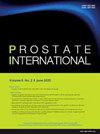Time to castrate the cost? the rising expense of chemical castration for the management of prostate cancer
IF 2.6
2区 医学
Q2 UROLOGY & NEPHROLOGY
引用次数: 0
Abstract
Background
Androgen deprivation therapy (ADT) remains the backbone of treatment of advanced prostate cancer. Conventionally, this is achieved by means of Gonadotropin Releasing Hormone (GnRH) analogs, though in recent years, four novel androgen receptor pathway inhibitors (nARPIs) have been approved for the treatment of advanced prostate cancer. We aim to analyze the increase in cost of chemical castration in advanced prostate cancer associated with the introduction of these medications.
Methods and methods
The publicly available Pharmaceutical Benefits Scheme database was accessed for conventional ADT and nARPI prescription data between January 2010 and January 2024. The number of prescriptions and cost of prescriptions were categorized by month and state. A descriptive analysis was performed outlining the therapy-prescribing patterns and discordances at a national and state-/territory-based level.
Results
From January 2010 to January 2024, over 1.7 million scripts were dispensed for conventional ADT compared to 412,925 for nAPRI therapy. The average cost for ADT rose from $9.9 million to 10.9 million. The average cost for nARPI therapy rose from $5.2 million to $17.3 million. There was significant difference between state-prescribing practices despite population-adjusted analysis.
Conclusions
While intensified treatment has proven to improve prostate cancer survival, this had led to an exponential increase in the cost of treatment. Clinicians must exercise caution when prescribing these medications to ensure patients will appropriately benefit from their advantage to cancer-specific survival in the context of their overall health to ensure appropriate distribution of resources.
时间阉割的代价?前列腺癌化学去势治疗费用的上升
背景:雄激素剥夺疗法(ADT)仍然是晚期前列腺癌治疗的支柱。传统上,这是通过促性腺激素释放激素(GnRH)类似物来实现的,尽管近年来,四种新型雄激素受体途径抑制剂(narpi)已被批准用于治疗晚期前列腺癌。我们的目的是分析化学阉割在晚期前列腺癌患者中与这些药物引入相关的成本增加。方法和方法对2010年1月至2024年1月期间的常规ADT和nARPI处方数据进行检索。处方数量和处方费用按月份和州进行分类。进行了描述性分析,概述了国家和州/地区层面的治疗处方模式和不一致。结果2010年1月至2024年1月,常规ADT的处方分发量超过170万张,而nAPRI的处方分发量为412,925张。ADT的平均成本从990万美元上升到1090万美元。nARPI治疗的平均费用从520万美元上升到1730万美元。尽管进行了人口调整分析,但各州处方实践之间存在显著差异。结论:虽然强化治疗已被证明可以提高前列腺癌患者的生存率,但这也导致了治疗费用的指数级增长。临床医生在开这些药物处方时必须谨慎行事,以确保患者在整体健康的背景下能够适当地受益于它们对癌症特异性生存的优势,以确保资源的适当分配。
本文章由计算机程序翻译,如有差异,请以英文原文为准。
求助全文
约1分钟内获得全文
求助全文
来源期刊

Prostate International
Medicine-Urology
CiteScore
4.40
自引率
26.70%
发文量
40
审稿时长
35 days
期刊介绍:
Prostate International (Prostate Int, PI), the official English-language journal of Asian Pacific Prostate Society (APPS), is an international peer-reviewed academic journal dedicated to basic and clinical studies on prostate cancer, benign prostatic hyperplasia, prostatitis, and ...
 求助内容:
求助内容: 应助结果提醒方式:
应助结果提醒方式:


